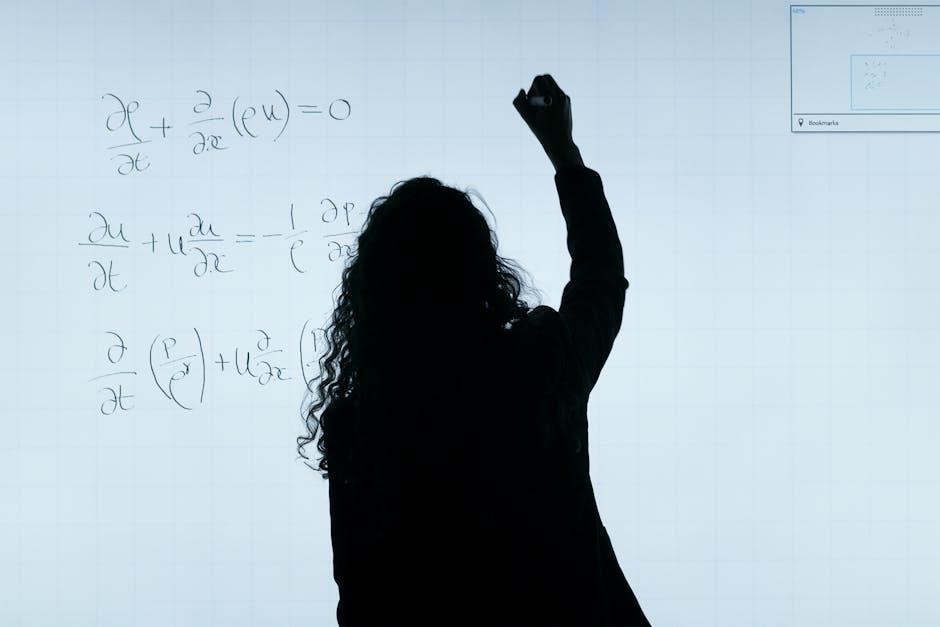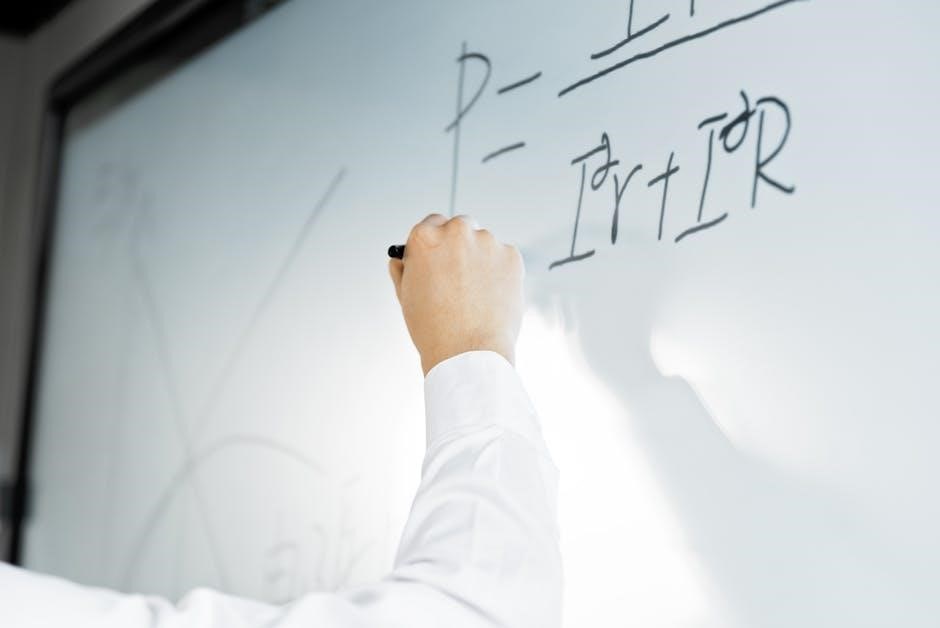Physics problems with solutions serve as invaluable tools for students seeking to deepen their understanding of the subject. Working through these problems reinforces theoretical concepts and enhances problem-solving skills. Accessing solutions in PDF format offers convenience and portability‚ allowing for study anytime‚ anywhere‚ as you can easily download and print them.

Types of Physics Problems
Physics encompasses a wide array of problem types. These problems vary significantly based on the specific area of physics they address. Common categories include mechanics‚ electromagnetism‚ thermodynamics‚ optics‚ and quantum mechanics. Each type requires different approaches and solution techniques‚ so understanding this diversity is essential for effective learning.
Mechanics Problems
Mechanics problems form a fundamental part of physics education. They delve into the study of motion‚ forces‚ and energy‚ providing a foundation for understanding more advanced topics. These problems often involve concepts like kinematics‚ dynamics‚ work‚ and power. Kinematics problems focus on describing motion‚ using equations to relate displacement‚ velocity‚ and acceleration‚ sometimes with calculus. Dynamics problems introduce forces using Newton’s Laws of Motion to analyze how forces affect motion‚ including friction and tension.
Work and energy problems explore the concepts of work‚ kinetic energy‚ potential energy‚ and the conservation of energy‚ using work-energy theorem. Example problems might involve projectile motion‚ inclined planes‚ or collisions. Solving mechanics problems requires a strong understanding of vector algebra and calculus and the ability to apply these mathematical tools to physical situations. The solutions to these problems usually involve a step-by-step approach‚ starting with identifying the relevant physical principles and equations‚ drawing free-body diagrams‚ and performing algebraic manipulations to find the unknown quantities. Mastering mechanics problems is crucial for success in physics.
Electromagnetism Problems
Electromagnetism problems explore the realm of electric and magnetic fields and their interactions with charged particles. These problems cover topics like electrostatics‚ magnetostatics‚ circuits‚ and electromagnetic induction. Electrostatics problems deal with stationary charges and electric fields‚ often using Coulomb’s Law and Gauss’s Law to calculate electric forces and fields. Magnetostatics problems concern steady currents and magnetic fields‚ employing Ampere’s Law and Biot-Savart Law to find magnetic fields due to current distributions. Circuit problems involve analyzing circuits with resistors‚ capacitors‚ and inductors‚ using Ohm’s Law and Kirchhoff’s Laws.
Electromagnetic induction problems explore Faraday’s Law and Lenz’s Law‚ dealing with changing magnetic fields inducing electric fields. Example problems might involve calculating the electric field due to a charge distribution‚ the magnetic field due to a current-carrying wire‚ or the current in a circuit with an inductor. Solving electromagnetism problems requires a strong foundation in vector calculus and a clear understanding of the relationships between electric and magnetic fields. Solutions typically involve applying vector calculus to calculate fields and using circuit laws to analyze current flow. Mastering electromagnetism problems is essential for understanding many technological applications.
Thermodynamics Problems
Thermodynamics problems delve into the study of heat‚ work‚ and energy transfer in physical systems. These problems often involve the laws of thermodynamics‚ including the zeroth‚ first‚ second‚ and third laws. The zeroth law deals with thermal equilibrium‚ while the first law is the conservation of energy. The second law introduces entropy and the direction of spontaneous processes. The third law concerns the behavior of systems at absolute zero temperature. Common thermodynamics problems involve calculating heat transfer‚ work done by or on a system‚ changes in internal energy‚ and entropy changes.
Example problems might include analyzing heat engines‚ refrigerators‚ and heat pumps. These problems often require applying thermodynamic cycles like the Carnot cycle or the Rankine cycle. Other problems might involve calculating the heat capacity of a substance or determining the equilibrium temperature of a mixture. Solving thermodynamics problems requires a clear understanding of thermodynamic principles and the ability to apply them to real-world systems. Solutions often involve using thermodynamic tables and diagrams to determine properties of substances. Mastering thermodynamics problems is crucial for understanding energy-related phenomena and engineering applications‚ as it provides the fundamental principles behind energy conversion and transfer processes.
Optics Problems
Optics problems explore the behavior of light and its interaction with matter. These problems cover a wide range of topics‚ including reflection‚ refraction‚ diffraction‚ interference‚ and polarization. Reflection problems often involve calculating the angle of reflection or determining the position and characteristics of an image formed by a mirror. Refraction problems explore the bending of light as it passes from one medium to another‚ often requiring the use of Snell’s law to calculate the angle of refraction.
Diffraction problems delve into the spreading of light waves as they pass through an aperture or around an obstacle‚ leading to phenomena like diffraction patterns. Interference problems investigate the superposition of light waves‚ resulting in constructive or destructive interference‚ and are crucial in understanding phenomena like thin-film interference and interferometry. Polarization problems examine the orientation of the electric field vector of light waves and its effects on transmission through polarizing materials. Solving optics problems requires a solid understanding of wave optics principles and the ability to apply them to various optical systems. Solutions often involve ray diagrams‚ wave equations‚ and trigonometric relationships. Mastering optics problems is essential for understanding optical instruments‚ imaging systems‚ and the fundamental nature of light.
Quantum Mechanics Problems
Quantum mechanics problems delve into the realm of the very small‚ exploring the behavior of matter and energy at the atomic and subatomic levels. These problems often involve concepts such as wave-particle duality‚ superposition‚ quantum entanglement‚ and the uncertainty principle. Solving them requires a strong foundation in linear algebra‚ differential equations‚ and probability theory.
Typical problems include calculating the energy levels of a particle in a potential well‚ determining the probability of finding a particle in a specific region of space‚ and analyzing the behavior of quantum systems under various perturbations. Understanding the time-independent and time-dependent Schrödinger equations is crucial for tackling these problems. PDF resources offering solved quantum mechanics problems are invaluable for students‚ providing step-by-step solutions and explanations. These resources often cover topics like the harmonic oscillator‚ hydrogen atom‚ and scattering theory. Mastering quantum mechanics problems is essential for understanding the fundamental principles governing the behavior of matter at the quantum level and its applications in fields like quantum computing and materials science. The abstract nature of quantum mechanics demands a careful and methodical approach to problem-solving.

Resources for Physics Problem Solutions
Finding reliable physics problem solutions is crucial for students. Many resources exist‚ including online problem solvers‚ physics textbooks with detailed solutions‚ and PDF collections of solved problems. These resources offer valuable support for understanding concepts and mastering problem-solving techniques.
Online Problem Solvers
Online problem solvers have emerged as indispensable tools for physics students seeking assistance with complex problems. These platforms offer a diverse range of solutions‚ often accompanied by step-by-step explanations‚ catering to various levels of difficulty. One can find many websites that provide physics help‚ some with free and subscription-based access.
Many of these resources provide help for students in colleges and high schools. These platforms frequently feature forums where students can post questions and receive guidance from experienced tutors or fellow learners. Interactive simulations and visual aids further enhance understanding‚ making complex concepts more accessible.
However‚ it’s crucial to exercise caution when utilizing online problem solvers. Students should prioritize understanding the underlying principles rather than blindly copying solutions. These tools should serve as a supplement to traditional learning methods‚ encouraging critical thinking and independent problem-solving skills. It’s also essential to verify the accuracy of solutions provided by online platforms to ensure a comprehensive learning experience. Remember‚ the goal is to learn‚ not just to find an answer.
Physics Textbooks with Solutions
Physics textbooks with solutions manuals are a cornerstone of physics education‚ offering a structured approach to learning and problem-solving. These resources provide a comprehensive compilation of problems spanning various topics‚ accompanied by detailed solutions that guide students through the problem-solving process. Textbooks often feature a wide range of problems‚ from basic exercises to more challenging applications‚ catering to different skill levels.
The solutions manuals included with these textbooks serve as invaluable learning aids‚ providing step-by-step explanations and insights into the underlying concepts. By studying these solutions‚ students can gain a deeper understanding of the problem-solving strategies and develop their analytical skills. Moreover‚ textbooks often include supplementary materials‚ such as practice quizzes and review questions‚ to reinforce learning and assess comprehension.
The availability of solutions manuals promotes self-study and independent learning‚ enabling students to work through problems at their own pace and track their progress. However‚ it’s crucial to use these resources judiciously‚ focusing on understanding the solution process rather than simply memorizing answers. Textbooks with solutions are essential for any serious student.

PDF Collections of Solved Problems
PDF collections of solved physics problems are a readily accessible and convenient resource for students and educators alike. These collections offer a curated selection of problems covering various physics topics‚ accompanied by detailed solutions presented in a portable document format (PDF). The availability of these collections allows for easy access and offline study‚ making them ideal for students preparing for exams or seeking additional practice.
These PDF collections often contain a diverse range of problems‚ from introductory-level exercises to more advanced challenges‚ catering to different skill levels and areas of interest. The solutions provided are typically step-by-step‚ guiding students through the problem-solving process and highlighting key concepts and principles. Furthermore‚ some collections may include additional features such as diagrams‚ graphs‚ and annotations to enhance understanding.
PDF collections can be found online through various sources‚ including university websites‚ educational repositories‚ and physics forums. They serve as valuable supplements to textbooks and classroom instruction‚ providing students with ample opportunities to practice and refine their problem-solving skills. However‚ students should critically evaluate the quality and accuracy of the solutions.

Example Problems and Solutions (PDF Format)
This section provides example physics problems with detailed solutions in PDF format. These examples cover fundamental concepts and problem-solving techniques. Downloading these PDFs allows offline access and convenient study‚ aiding in understanding key physics principles effectively‚ and offers portability.
Kinematics Example with Solution
Kinematics problems involve describing motion without considering the forces that cause it. A typical kinematics problem might involve calculating the displacement‚ velocity‚ or acceleration of an object given certain initial conditions and constraints. For instance‚ consider a projectile motion problem where an object is launched at an angle‚ and we need to determine its range‚ maximum height‚ or time of flight.
To solve such a problem‚ we typically use kinematic equations that relate displacement‚ initial velocity‚ final velocity‚ acceleration‚ and time. These equations allow us to find unknown quantities when we know enough information about the motion. A PDF document containing a solved kinematics example would typically provide a detailed step-by-step solution‚ showing how to apply these equations to a specific scenario.
The solution would include identifying the known and unknown variables‚ choosing the appropriate kinematic equation(s)‚ and solving for the unknown(s). The PDF might also include diagrams or graphs to illustrate the motion and make the solution easier to understand. This resource would be invaluable for students learning kinematics.
Newton’s Laws Example with Solution
Newton’s Laws of Motion form the foundation of classical mechanics‚ describing the relationship between forces acting on an object and its motion. A typical problem might involve analyzing the forces acting on an object on an inclined plane‚ or determining the acceleration of multiple connected objects. These problems often require applying Newton’s First Law (inertia)‚ Second Law (F=ma)‚ and Third Law (action-reaction).
A PDF document providing a solved example would start by clearly stating the problem‚ followed by a detailed solution. The solution would typically involve drawing a free-body diagram to visualize all the forces acting on the object(s). Then‚ Newton’s Second Law would be applied in component form to each object‚ resulting in a system of equations.
Solving this system of equations would yield the unknown quantities‚ such as acceleration‚ tension‚ or normal force. The PDF might also include explanations of the assumptions made and potential sources of error. Such an example would be highly beneficial for students learning to apply Newton’s Laws in various scenarios‚ improving their analytical and problem-solving skills.
Energy Conservation Example with Solution
The principle of energy conservation is a cornerstone of physics‚ stating that the total energy of an isolated system remains constant. Problems involving energy conservation often require analyzing the transformation of energy between different forms‚ such as kinetic energy‚ potential energy (gravitational or elastic)‚ and thermal energy.
A sample problem with a solution in PDF format could involve a roller coaster moving along a track. The problem would typically ask to find the speed of the roller coaster at a certain point‚ or the height it reaches at another point‚ assuming no energy loss due to friction or air resistance.
The solution would start by identifying the initial and final states of the system. Then‚ it would equate the total initial energy to the total final energy‚ taking into account all forms of energy present. The resulting equation would then be solved for the unknown variable. The PDF solution would also provide helpful diagrams‚ explanations of the energy transformations‚ and potential complications such as non-conservative forces. By studying this example‚ students can learn to effectively apply the principle of energy conservation and enhance their problem-solving abilities.
